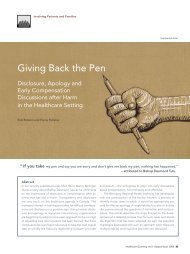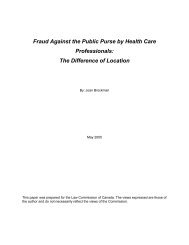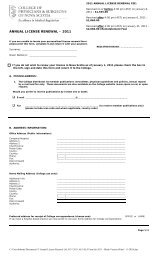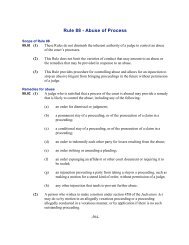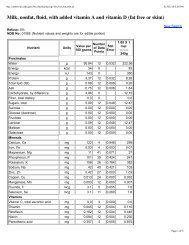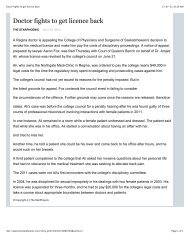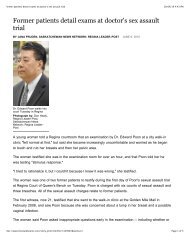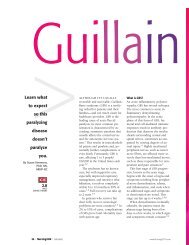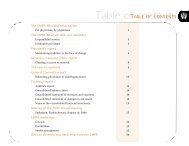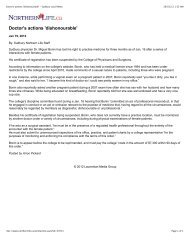Experiments That Changed Nutritional Thinking - TUUM EST
Experiments That Changed Nutritional Thinking - TUUM EST
Experiments That Changed Nutritional Thinking - TUUM EST
You also want an ePaper? Increase the reach of your titles
YUMPU automatically turns print PDFs into web optimized ePapers that Google loves.
1040S<br />
SUPPLEMENT<br />
TABLE 1<br />
TABLE 2<br />
Effects of food restriction on life span of rats1<br />
Effects of food restriction on the weight and density of the<br />
femur of rats1<br />
Median age<br />
Group Ave. age at death Group Mean weight Density<br />
d<br />
I Unrestricted<br />
Males (n Å 11) 0.741 1.22<br />
I Unrestricted Females (n Å 18) 0.540 1.21<br />
Males (n Å 14) 483 522 II Restricted at weaning<br />
Females (n Å 22) 801 820 Males (n Å 7) 0.486 1.15<br />
II Restricted at weaning Females (n Å 13) 0.398 1.13<br />
Males (n Å 13) 820 797 III Restricted 2 wk after weaning<br />
Females (n Å 23) 775 904 Males (n Å 9) 0.484 1.09<br />
III Restricted 2 wk after weaning Females (n Å 10) 0.432 1.14<br />
Males (n Å 15) 894 919<br />
Females2 (n Å 19) 826 894 1 Data taken from McCay et al. (1935).<br />
1 Data taken from McCay et al. (1935).<br />
2 Two female rats in this group died at a young age due to high Table 2 provides data regarding the weight and density of the<br />
temperatures in the animal room. They were not included in the calcula- femur at the time of death.<br />
tion of results.<br />
Confirmation of the Relationship of Diet to Longevity<br />
publishing the first report from this work in 1934 while some<br />
In a second experiment, McCay and his group fed all rats<br />
of the rats were yet alive (McCay and Crowell 1934). McCay<br />
and his co-author remarked on the long-held viewpoint that<br />
identical amounts of a nutrient-dense diet, feeding that<br />
nutrition and life span were related (Darby 1990). Yet, they<br />
amount required to just maintain the weight of the restricted<br />
rats. This allowed them to determine whether the unlimited<br />
noted, the science of nutrition had focused on the young,<br />
consumption of a nutrient-dense diet had shortened the life<br />
growing animal to the exclusion of the study of the adult or<br />
of the control group from the first experiment, and they conaging<br />
animal.<br />
cluded it had not. The growth of the rats was controlled by<br />
They wrote: ‘‘In this day when both children and animals<br />
varying the amount of a mixture of sucrose, cooked starch and<br />
are being fed to attain a maximum growth rate, it seems a<br />
lard (38:57:5) that was fed, with the control rats being allowed<br />
little short of heresy to present data in favor of the ancient<br />
to eat as much as they chose. In addition, the control group<br />
theory that slow growth favors longevity.’’ They cited the earwas<br />
divided, with half the rats being fed cod liver oil and half<br />
lier work of Osborne et al. (1917) and their own previous<br />
(as well as all rats with restricted intakes) being fed irradiated<br />
observations that trout with very low protein intake ‘‘failed to<br />
grow [but remained alive and] lived twice as long as those<br />
yeast and carotene as sources of fat-soluble vitamins. Supple-<br />
mentation with these different sources of fat-soluble nutrients<br />
that grew.’’ They postulated that ‘‘something was consumed<br />
in growth that is essential for the maintenance of life’’ (McCay<br />
and Crowell 1934).<br />
Accordingly, McCay and Crowell selected from their colony<br />
TABLE 3<br />
106 rats, both male and female, and divided them into<br />
Effects of various lengths of food restriction on<br />
three groups. They fed them all the same nutrient-dense diet<br />
the life span of rats1<br />
from the time of weaning. However, Group I was fed unlimited<br />
amounts of the diet, whereas the others were fed restricted<br />
Age at death<br />
amounts of the diet, either from the time of weaning (Group<br />
II) or after 2 wk (Group III). Restricted rats were maintained<br />
at a constant weight until once about every 100 d when they<br />
Group Ave. Range<br />
were allowed to grow about 10 g because of the feeding of<br />
d<br />
sucrose or beef liver to all rats.<br />
I Unrestricted2<br />
A full report was published on this initial experiment a year Males (n Å 17) 670 308–896<br />
after the preliminary report (McCay et al. 1935). Table 1 presents Females (n Å 16) 643 404–965<br />
data concerning the length of life of these rats. The female rats II Restricted until d 300<br />
that were fed unrestricted amounts of diet lived significantly Males (n Å 4) 865 805–1018<br />
longer than the comparable males (median age at death 820 vs Females (n Å 5) 811 555–1183<br />
522 d). Male rats that were fed restricted amounts of diet, how-<br />
Restricted until d 500<br />
Males (n Å 5) 806 366–1103<br />
ever, lived as long, and in some cases longer, than did the females Females (n Å 5) 990 793–1078<br />
whose intake was restricted. The life of the male rats was clearly Restricted until d 700<br />
lengthened by food restriction and the slower rate of growth, Males (n Å 4) 874 772–1025<br />
whereas the life of the slower-growing females was not lengthened Females (n Å 6) 912 406–1320<br />
greatly, if at all, by food restriction.<br />
Restricted until d 1000<br />
McCay et al. (1935) also observed the effects of food restric-<br />
Males (n Å 5) 882 336–1127<br />
Females (n Å 4) 1033 815–1320<br />
tion on the growth and composition of several tissues. Their<br />
most striking observation was of the fragility of the bones taken 1 Data taken from McCay et al. (1939).<br />
from the rats fed restricted amounts of diet. They reported that<br />
2 Data for controls, fed either carotene / irradiated yeast or cod<br />
some of the bones ‘‘crumbled in the course of dissection.’’ liver oil, were combined.<br />
/ 4p09$$0062 04-07-97 14:02:12 nutras LP: J Nut May Suppl<br />
Downloaded from jn.nutrition.org by on June 3, 2010



